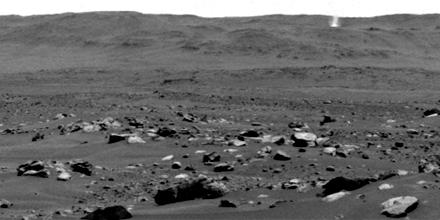NASA's Perseverance Rover Captures Mars Whirling Spectacle
02.10.2023 posted by Admin

A fresh collection of pictures sent back by NASA's Perseverance Mars Rover seems to reveal a swirling dust devil moving across the surface of the red planet, located approximately 2.5 miles away from the six-wheeled geologist.
This intriguing phenomenon was spotted on August 30, 2023, as only the lower part of the dust devil was observed meandering along the western rim of Mars' Jezero Crater.
These images were taken on Perseverance's 899th day on Mars.
The sequence of 21 pictures, captured at four-second intervals by one of the rover's Navcams, was compiled and then sped up by about 20 times to illustrate the movement of the dust devil.
Unlike Earth's powerful tornadoes, dust devils on Mars are milder and smaller, although they play a significant role in transporting and redistributing dust across the planet. Scientists often study these phenomena to gain insights into Mars' atmosphere and enhance current weather models.
Based on the imagery, NASA's mission scientists estimated that the dust devil was situated roughly 2.5 miles away on the "Thorofare Ridge," moving from east to west at a speed of about 12 mph. Its width was calculated to be nearly 200 feet, and though only the lower 387 feet of the dust devil were visible, scientists believe it to be over a mile in height.
While we cannot observe the top of the dust devil, the shadow it casts provides a valuable indicator of its height. According to Mark Lemmon, a planetary scientist at the Space Science Institute in Boulder, Colorado, and a member of the Perseverance science team, "Most are vertical columns. If this dust devil were configured that way, its shadow would indicate it is about 1.2 miles (2 kilometers) in height."
On Earth, dust devils form when rising warm air meets descending columns of cooler air. Martian dust devils, as NASA notes, can grow much larger than their Earthly counterparts.
Scientists are continuing their efforts to better understand when and where dust devils are likely to appear in specific locations.
For over two years, the rover has been exploring the Jezero Crater with the hope of eventually uncovering evidence of ancient microbial life.
This intriguing phenomenon was spotted on August 30, 2023, as only the lower part of the dust devil was observed meandering along the western rim of Mars' Jezero Crater.
These images were taken on Perseverance's 899th day on Mars.
The sequence of 21 pictures, captured at four-second intervals by one of the rover's Navcams, was compiled and then sped up by about 20 times to illustrate the movement of the dust devil.
Unlike Earth's powerful tornadoes, dust devils on Mars are milder and smaller, although they play a significant role in transporting and redistributing dust across the planet. Scientists often study these phenomena to gain insights into Mars' atmosphere and enhance current weather models.
Based on the imagery, NASA's mission scientists estimated that the dust devil was situated roughly 2.5 miles away on the "Thorofare Ridge," moving from east to west at a speed of about 12 mph. Its width was calculated to be nearly 200 feet, and though only the lower 387 feet of the dust devil were visible, scientists believe it to be over a mile in height.
While we cannot observe the top of the dust devil, the shadow it casts provides a valuable indicator of its height. According to Mark Lemmon, a planetary scientist at the Space Science Institute in Boulder, Colorado, and a member of the Perseverance science team, "Most are vertical columns. If this dust devil were configured that way, its shadow would indicate it is about 1.2 miles (2 kilometers) in height."
On Earth, dust devils form when rising warm air meets descending columns of cooler air. Martian dust devils, as NASA notes, can grow much larger than their Earthly counterparts.
Scientists are continuing their efforts to better understand when and where dust devils are likely to appear in specific locations.
For over two years, the rover has been exploring the Jezero Crater with the hope of eventually uncovering evidence of ancient microbial life.